Connecticut is a famous birding site in the United States. It’s home to about 280 species of birds. In the state’s extensive dense coniferous and deciduous forests, wetlands, barrier islands, and national wildlife refuges, birders are most likely to come across several types of hawks while exploring these prime bird habitats.
In this article, we will look at 8 types of hawks that are commonly found in Connecticut. From the White Memorial Conservation Centre in Litchfield and Long Island Sound to Hammonasset Beach State Park and Milford Point, Connecticut boasts a wide range of habitats where you can see these hawks.
1. Rough-legged Hawk
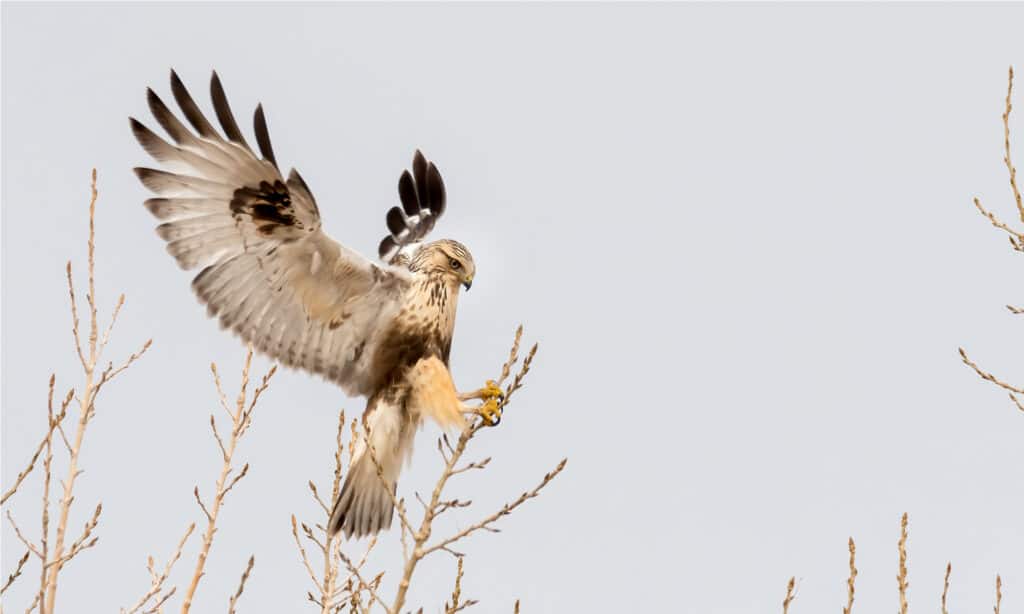
Rough-legged hawks inhabit arctic coasts and tundra escarpments.
©Eivor Kuchta/Shutterstock.com
| Rough-legged Hawk | |
|---|---|
| Scientific name | Buteo lagopus |
| Weight | 1.32-3.66 lbs (599-1660 g) |
| Height | 18-24 in (46-60 cm) |
| Wingspan | 52-54 in (132-138 cm) |
Rough-legged hawks are relatively large hawks that are commonly sighted in Connecticut in winter. They can be found in practically every state region, although they are most frequently seen in the western half. They are the only soaring Buteo hawks tied to cold climates. These hawks are feathered down their legs and on the tops of their feet. They have broad wings that are also fairly long and narrow. They are dark-brown hawks with pale underwings.
Rough-legged hawks inhabit arctic coasts and tundra escarpments. In winter, they spend most of their time in open fields, grasslands, prairies, marshes, and dunes. They breed in the tundra, particularly in areas where there are tall trees and cliff ledges for nest sites. They build their nests using debris, bones, and sticks lined with twigs and grass. Females lay between 3 and 5 pale bluish eggs that hatch in roughly 31 days.
When hunting, rough-legged hawks perch on tree branches, utility poles, and fence posts where they can watch for prey. They also soar over fields, scanning the ground below for meals. These raptors feed on voles, lemmings, small birds, and other small animals.
2. Red-shouldered Hawk
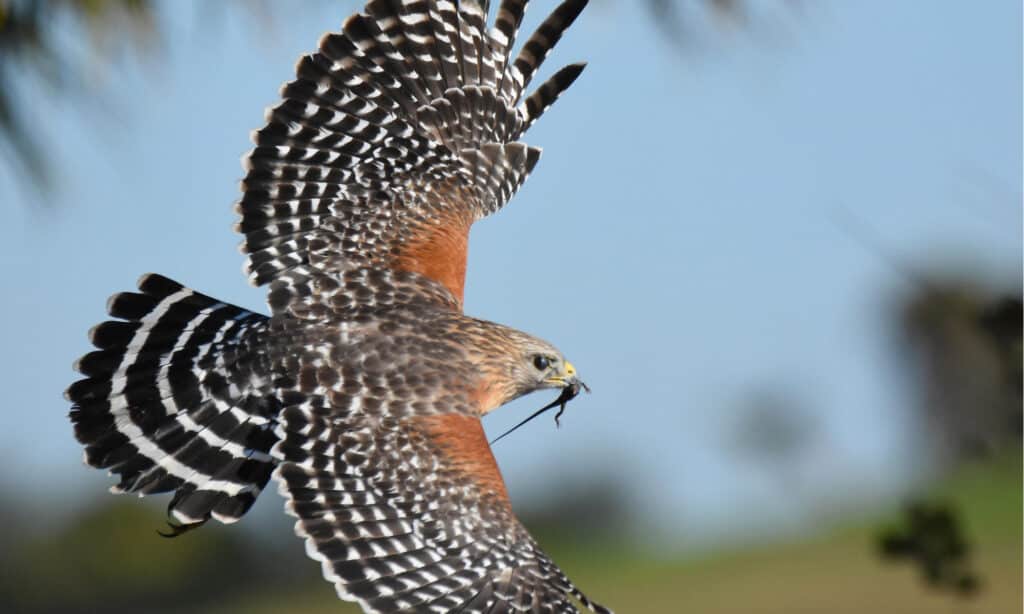
Red-shouldered hawks are known as the hawks of the woodlands.
©MTKhaled mahmud/Shutterstock.com
| Red-shouldered Hawk | |
|---|---|
| Scientific name | Buteo lineatus |
| Weight | 1-1.7 lbs (486-774 g) |
| Height | 15-24 in (38-61 cm) |
| Wingspan | 35-50 in (90-127 cm) |
Red-shouldered hawks are known as the hawks of the woodlands, which are often heard before they are seen due to their conspicuous clear whistled calls. They have medium-sized bodies with broad, rounded wings. They have white and dark checkered wings with a red barring on the underside. They are often found in the central regions of Connecticut.
Red-shouldered hawks inhabit the deciduous woodlands and mixed forests, often near swamps and rivers. The nest site is usually in a deciduous tree or conifer, located at the base of branches against a trunk. Females lay between 3 and 4 pale-bluish white eggs spotted with brown and lavender. Eggs hatch in roughly 33 days.
Their diet consists of small birds, voles, chipmunks, frogs, toads, mice, and occasionally fish. They watch for prey from a perch. Sometimes, they fly low in open areas, taking creatures by surprise.
3. Northern Goshawk

Northern goshawks breed in mixed woods, mature deciduous, or in pure stands of coniferous trees.
©Milan Zygmunt/Shutterstock.com
| Northern Goshawk | |
|---|---|
| Scientific name | Accipiter gentilis |
| Weight | 1.4-4.8 lbs (635-2177 g) |
| Height | 18-27 in (46-69 cm) |
| Wingspan | 40-46 in (103-117 cm) |
Northern goshawks are the largest of the accipiters. They have long tails and broad, rounded wings. Adults are gray on top and light gray with black horizontal bars and vertical streaks on their underparts. Females are typically larger and more heavily marked below. These hawks have distinctive black heads with a wide white stripe over their eyes. They are found in almost all areas of Connecticut but are often spotted in the southern half of the state.
Northern goshawks inhabit the forests. They breed in mixed woods, mature deciduous, or in pure stands of coniferous trees. Nests are built mostly by females while males supply the materials. Females lay between 2-4 bluish-white eggs that hatch in roughly 32-38 days.
These raptors are stealthy predators that hunt by quietly perching on low trees, often moving from one perch to another, and then with quick, agile flight. They feed mostly on medium-sized birds, snowshoe hares, squirrels, rabbits, insects, snakes, and small rodents.
4. Northern Harrier

Northern harriers primarily feed on small birds such as flickers, songbirds, robins, doves, and small ducks.
©Harry Collins Photography/Shutterstock.com
| Northern Harrier | |
|---|---|
| Scientific name | Circus hudsonius |
| Weight | 11-27 oz (300-750 g) |
| Height | 21-25 in (53-64 cm) |
| Wingspan | 41-46 in (103-117 cm) |
Northern harriers are slim, medium-sized birds of prey commonly sighted in Connecticut in the winter months. Their wings are broad, with a long, rounded tail. Males are gray on top with whitish underparts. Females and immatures are brown with black-banded tails.
Northern harriers inhabit the fields, marshes, and prairies. They live in any kind of terrain, both wet and dry habitats. They build their nest in dense fields or marshes. Females build the nest while males supply the materials. Females lay between 4-6 pale bluish-white eggs that hatch in roughly 30-32 days.
These hawks primarily feed on small birds such as flickers, songbirds, robins, doves, and small ducks. They also eat lizards, snakes, large insects, and toads. They usually fly over low fields, watching for prey movement on the ground. Also, they locate prey by sound.
5. Red-tailed Hawk
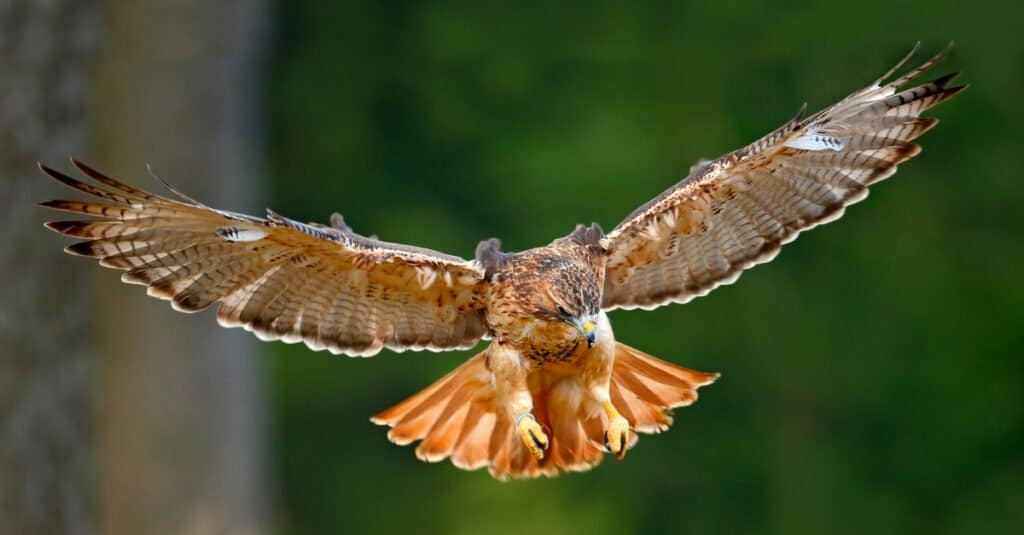
Red-tailed hawks inhabit the prairie groves, mountains, and woodlands.
©Ondrej Prosicky/Shutterstock.com
| Red-tailed Hawk | |
|---|---|
| Scientific name | Buteo jamaicensis |
| Weight | 1.5-3.5 lbs (680-1586 g) |
| Height | 18-26 in (45-65 cm) |
| Wingspan | 43-56 in (110-141 cm) |
Red-tailed hawks are large Buteo hawks with vivid red tails. You’d think you saw an eagle if you watched one from a distance. They are brown on top with a pale-streaked belly. They are widespread in Connecticut all year. They have been most frequently spotted in the central regions of the state.
These raptors love spending most of their time in the open country. They inhabit the prairie groves, mountains, and woodlands. They nest on cliff ledges and on the tops of tall trees. Females lay 2-3 eggs that are blotched with brown. The incubation period lasts for around 28-35 days.
Red-tailed hawks feed on rats, voles, rabbits, snakes, bats, frogs, toads, ground squirrels, and small birds. They hunt by watching from a raised perch or flying over fields, scanning for prey below.
6. Cooper’s Hawk

Cooper’s hawks are birds of prey with long tails and broad, rounded wings.
©Richard G Smith/Shutterstock.com
| Cooper’s Hawk | |
|---|---|
| Scientific name | Accipiter cooperii |
| Weight | 7.8-14.5 oz (220-410 g) |
| Height | 14-20 in (35-50 cm) |
| Wingspan | 24-39 in (62-99 cm) |
Cooper’s hawks are birds of prey with long tails and broad, rounded wings. Adult hawks are grayish-blue on top with a warm reddish barring underneath. The immatures are brown above with a crisply streaked upper chest. They are very similar to sharp-shinned hawks but have larger heads. These hawks are very common in Connecticut year-round with their extensive range.
Cooper’s hawks live in wooded habitats, ranging from backyards and leafy subdivisions to deep forests. They build their nests in mixed woods, coniferous, and deciduous forests, preferably where there are tall trees with clearings nearby. Both sexes build the nest, which comprises a bulky structure of sticks lined with softer materials. Females lay between 3-5 pale bluish-white eggs that hatch in 34-36 days.
Their diet consists mainly of birds and small mammals. They hunt for robins, flickers, jays, chipmunks, ground squirrels, large insects, and others by watching from a perch. They also listen and watch for prey, then put on a full burst of speed to catch it.
7. Sharp-shinned Hawk
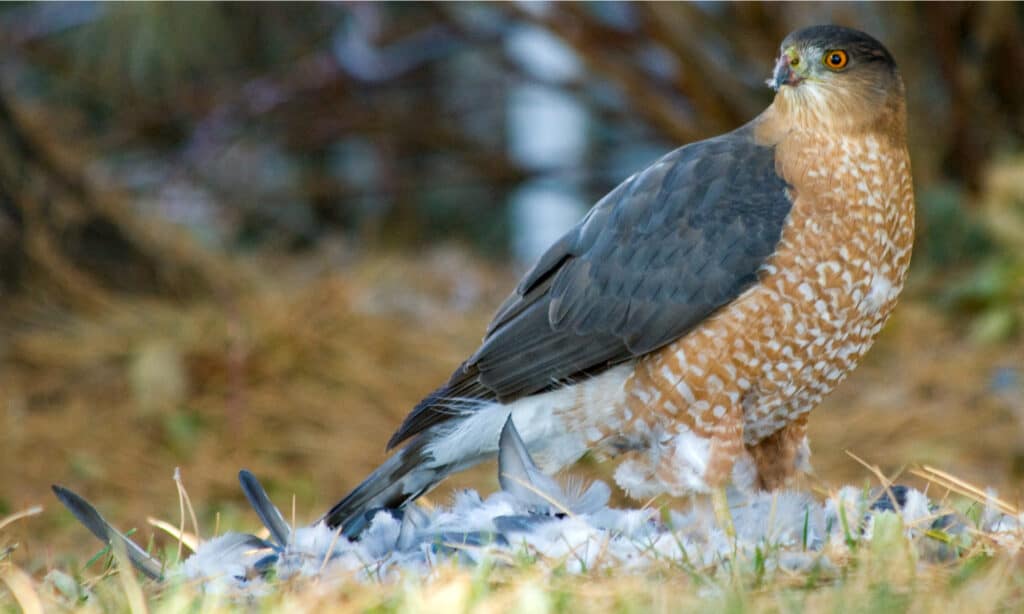
Sharp-shinned hawks feed on small birds, rodents, frogs, lizards, snakes, large insects, and squirrels.
©Wyatt W/Shutterstock.com
| Sharp-shinned Hawk | |
|---|---|
| Scientific name | Accipiter striatus |
| Weight | 2.9-7.7 oz (82-219 g) |
| Height | 9.1-15 in (23-37 cm) |
| Wingspan | 17-27 in (42-68 cm) |
Sharp-shinned hawks are very similar to Cooper’s hawks but a bit smaller. They have short, squared tails with rounded wings. Adults are blue-gray on top with unique red-orange bars on the breast. Their bellies are also strikingly pale. They are often found in Connecticut.
These hawks inhabit the forested regions within the state. Sharp-shinned hawks build their nest in dense deciduous trees or groves of coniferous trees. Both sexes bring the nesting materials, but females do most of the construction work. They may build their nests on top of other old nests of squirrels and large birds. Females lay between 4-5 bluish-white eggs that are marked with brown. The incubation period lasts for 30-35 days.
Sharp-shinned hawks feed on small birds, rodents, frogs, lizards, snakes, large insects, and squirrels. They hunt primarily by perching inside foliage and waiting for potential prey to approach. They are agile fliers that like speeding through dense woods to surprise prey.
8. Broad-winged Hawk
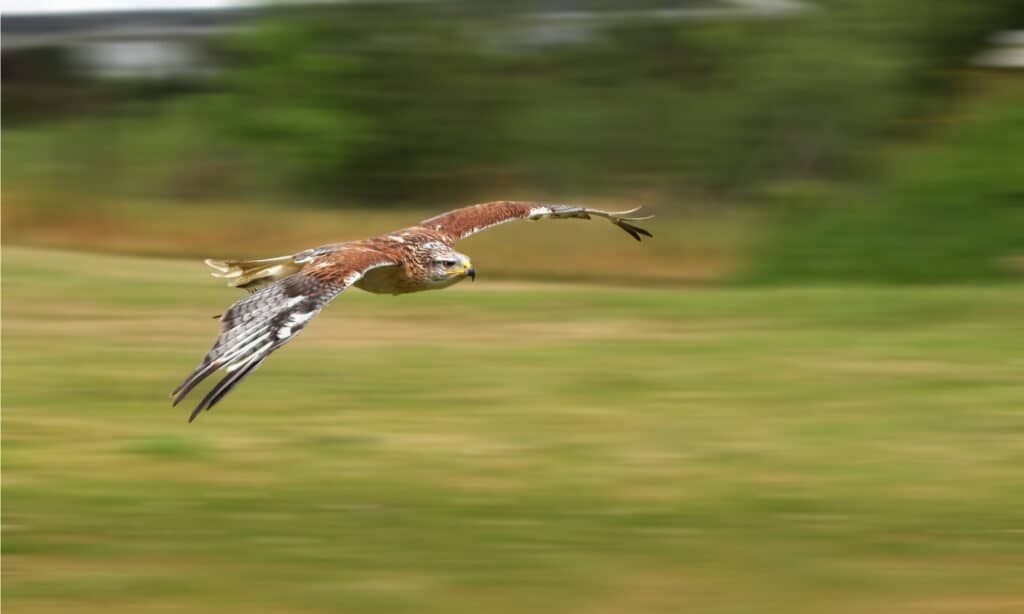
Broad-winged hawks are migratory birds of prey and are commonly sighted in Connecticut during winter.
©pr2is/Shutterstock.com
| Broad-winged Hawk | |
|---|---|
| Scientific name | Buteo platypterus |
| Weight | 9.3-19.8 oz (264-561 g) |
| Height | 13.4-17.3 in (34-44 cm) |
| Wingspan | 31.9-39.4 in (81-100 cm) |
Broad-winged hawks are small hawks with chunky bodies. They have large heads with short, squared tails. They are dark-brown above with pale cinnamon-streaked bellies. They have black-and-white banded tails. The immatures are light brown with coarse streaks underneath. These hawks are migratory birds of prey and are commonly sighted in Connecticut during winter.
Broad-winged hawks are normally found in forests, where they like to spend their time underneath the canopy. They breed in mixed coniferous-deciduous or pure deciduous forests, often near water, edges, and clearings. Both sexes build their nest in the lower part of large trees. Females lay between 2-3 whitish eggs that are spotted with brown.
Broad-winged hawks feed on mice, voles, large insects, young turtles, lizards, and small birds. They hunt by watching for prey from a perch. They also hunt occasionally by flying along watercourses or through the woods.
The photo featured at the top of this post is © Ondrej Prosicky/Shutterstock.com
Thank you for reading! Have some feedback for us? Contact the AZ Animals editorial team.






